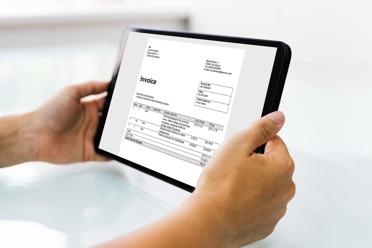PO vs. non-PO invoices
- Introduction
- The difference between PO and non-PO invoices
- What is a PO invoice?
- What is a non-PO invoice?
- The PO invoice procurement process
- Approving the purchase requisition
- The non-PO invoice procurement process
- Automating invoice approvals
- How AI is redefining PO and non‑PO invoice processes
- Frequently asked questions about PO vs. non-PO invoice processing
Hear what's covered in this article:
Accounts payable is responsible for managing the processing of supplier invoices, from reception of the invoice, through coding and approvals, until the payment is posted in the ERP or financial system and ready for payment. There are two main types of supplier invoices: purchase order-based invoices, also called PO invoices, and expense invoices (or non-PO invoices).
The difference between PO and non-PO invoices
The difference between PO and non-PO invoices lies in the purchase that generated the invoice. When a purchase requisition process is in place, the purchase will be triggered by a pre-approved purchase order (PO) that is sent to the supplier. In the case of purchases made outside the regulated purchase process, a non-PO invoice, also called an expense invoice, is sent from the supplier.

What is a PO invoice?
A PO invoice is one that has a purchase order attached to it. These invoices are generated after the approval of a purchase order. PO invoices contain details about the goods or services procured, and a matching purchase order number. When PO invoices are received by the AP department, they are matched against the corresponding purchase order. This ensures that there are no inconsistencies between the original purchase order and the PO invoice. PO invoices are usually pre-approved.
Modern AP platforms can now auto‑match PO invoices and route them for quick review and coding, drastically reducing manual steps and making approvals faster, more accurate, and less prone to error.
Common examples of PO invoices:
Vendor invoices
Invoices for goods received
Invoices for normal goods
What is a non-PO invoice?
As the name suggests, a non-PO invoice is one that doesn’t have a corresponding purchase order. Such invoices are also known as expense invoices, and usually indicate any indirect purchases made by a business. Owing to the nature of indirect procurement, non-PO invoices are generally not pre-approved.
Non-PO invoices are also used to make payments to suppliers when a particular invoice is within the company’s spend limit.
Modern AI‑powered platforms can now categorize invoices as PO or non‑PO automatically, significantly reducing misclassification and minimizing the need for manual review.
Common examples of non-PO invoices:
Reimbursement for employee travel expenses
Reimbursement for employee parking or driving fees
Service invoices
The PO invoice procurement process
Identify needs and budgeting
The process begins with decision-makers and business leaders identifying what they need to purchase in order to generate profits. They then make appropriate budgets for procuring such goods and services.
Submit a purchase requisition
Based on the requirements, an employee in the procurement department submits a purchase requisition depending on the quotes they receive from different vendors.
Approving the purchase requisition
The purchase requisition is reviewed and, if everything is in order, approved by the appropriate authority within the organization.
Issuing a purchase order
Once the purchase requisition is approved, a purchase order is issued to the vendor. The purchase order is an official document, indicating the business’ commitment to pay the vendor for specified goods or services.
Vendor confirmation
Upon receiving the PO, the vendor confirms whether the order can be fulfilled or not, and then begins preparing it for shipment.
Shipping and receipt of goods
The vendor ships the goods, and the receiving department within the organization checks the goods received against the purchase order.
Vendor provides a PO invoice
Once the goods are shipped, the vendor then provides an invoice using the same PO number, which is the PO invoice.
Invoice verification and payment
The PO invoice is matched against the purchase order and goods receipt to ensure all details correspond. If everything matches, the invoice is processed for payment.
The non-PO invoice procurement process
Identify needs and make purchases
Non-PO invoices often arise from smaller, regular expenditures, reimbursements for employee expenses, or legally contracted services. These purchases are usually made as and when the need arises, without going through the standard PO process.
Receipt of non-PO invoice
The vendor or service provider sends a non-PO invoice for the goods or services provided.
Review of invoice
The accounts payable department reviews the invoice. This includes checking the details of the invoice, verifying that the goods or services were received, and confirming that the invoice amount is within the company's spend limit.
Approval process
Since non-PO invoices are not pre-approved, they undergo an approval process. This often involves multiple steps and may require approval from several different people within the organization, depending on the amount of the invoice and the company's internal approval hierarchy.
Payment of invoice
Once all necessary approvals have been obtained, the invoice is processed for payment.
Automating invoice approvals
Automating invoice approvals with Medius, a cloud-based AP automation solution, can significantly enhance the efficiency and accuracy of your business operations. By eliminating the need for manual data entry, printing, or scanning, Medius reduces the potential for error, automating invoice scanning and capture for greater accuracy and saving your business both time and money. Invoices can be approved on the go, providing flexibility and ensuring timely approvals.
Modern AI platforms evolve with your workflow, narrowing the gap between how PO and non‑PO invoices are treated. Today, both can benefit from seamless matching, automated routing, and adaptive approvals, making the entire invoice process more streamlined, transparent, and secure.
How AI is redefining PO and non‑PO invoice processes
Modern automated payment platforms utilize AI and machine learning to transform how businesses review, validate, and process invoices. These intelligent technologies learn from historical transaction data, recognize complex patterns and adapt over time, making the payments process more accurate, efficient and resilient.

AI doesn't just identify issues, it resolves them. It analyzes mismatches, recognizes patterns, and automatically corrects discrepancies based on past resolution logic.
AI also flags unusual payment behavior, strengthening fraud detection and reducing risk, especially with less structured non-PO invoices.
With AI embedded in the workflow, businesses can reduce manual review, streamline approvals, and gain deeper insights. Predictive analytics also forecast invoice volume trends and potential bottlenecks allowing teams to allocate resources proactively.
Accounts payable efficiency has evolved significantly over the past five years. In 2020, the average touchless rate was roughly 68%, while top-performing businesses achieved about 97%. Today, averages have risen to 70%, with leaders nearing 99%.
This trend reflects how intelligent automation is erasing the operational divide between PO and non-PO invoices making both processes faster, more resilient, and easier to scale.

Explore benchmarks for PO and non-PO invoices
Discover the distinct benchmarks for PO and non-PO invoices to understand how they impact your accounts payable workflow.

Measure your AP efficiency: PO vs. non-PO benchmarks
Explore benchmarks for PO and non-PO invoices to enhance your AP process and compare with industry leaders.
Frequently asked questions about PO vs. non-PO invoice processing
Use a PO invoice for structured, pre-approved purchases like goods or contracted services. Non-PO invoices are better for urgent, recurring, or low-value purchases that don’t require a formal PO.
Yes. AI can route non-PO invoices to the right approver based on past behavior, department rules, or spend thresholds, automating what was previously manual.
Medius uses AI to match, validate, and classify invoices while detecting anomalies and routing exceptions, reducing errors and fraud risk across both invoice types.






